Geometric Processing and Accuracy Verification of Zhuhai-1 Hyperspectral Satellites
Abstract
:1. Introduction
2. Methods
2.1. Geometric Calibration
- (1).
- Using the DOM of the calibration field as a reference, select the spectral segment that is closest to the radiating characteristics of the DOM image as the starting spectral segment (assuming this is spectral segment N), use a high-precision matching algorithm to match N and DOM, obtain control points, and determine and , of N using Equation (4);
- (2).
- According to the calibration parameters solved in step (1), construct the geometric positioning model of N using Equation (4);
- (3).
- Register spectral segment N-1 and spectral segment N to obtain the corresponding points , and calculate the ground coordinates corresponding to the image points according to the geometric positioning model of N constructed in step (2). Taking as the geometric control point of N-1, the offset matrix of N-1 is the same as that of N in step 1). Solve for , of N-1 using Equation (4) and update the geometric positioning model of N-1;
- (4).
- Repeat step (3) until the geometric calibration of spectral segment 1 is completed;
- (5).
- For spectral segment N+1 to 32, follow steps (3) to (4) to recursively complete the geometric calibration.
2.2. Production
- (6).
- Using the geometric calibration results, establish a geometric positioning model for each spectral segment of the OHS according to Equation (4);
- (7).
- Select the intermediate spectral segment as the reference spectral segment (such as the 15th spectral segment), which has an image size of . Based on the spectral segment geometric positioning model established in (1), the terrain-independent method is used to generate the RPC parameters of the spectral segment;
- (8).
- For any of the spectral segments N (N≠15), generate a new image of size as follows:
- (a)
- For any image point on the image, calculate the ground coordinate corresponding to using the geometric positioning model of the reference spectral segment;
- (b)
- Calculate corresponding to the image point coordinate in spectral segment N by using the positioning model of N;
- (c)
- Calculate the gray value at using the linear interpolation method and assign to the new image;
- (d)
- Repeat steps (a)–(c) until all pixels of the new image have been calculated.
- (9).
- Repeat step (3) until all segments have been resampled.
3. Results and Discussion
3.1. Study Areas and Data Sources
3.2. Geometric Calibration
3.3. Band-to-Band Registration Accuracy
3.4. Interior Orientation Determination Accuracy Evaluation
3.5. Results of Block Adjustment
4. Conclusions
Author Contributions
Funding
Acknowledgments
Conflicts of Interest
References
- Orbita. Orbita. Available online: https://www.myorbita.net/ (accessed on 1 March 2019).
- Zhan, H. The First Two Satellite OVS-1A/1B of Zhuhai-1 Remote-sensing Micro-nano Satellites Constellation Launched Successfully. Space Int. 2017, 462, 1674–9030. [Google Scholar]
- Tadono, T.; Shimada, M.; Murakami, H.; Takaku, J. Calibration of PRISM and AVNIR-2 onboard ALOS daichi. IEEE Trans. Geosci. Remote Sens. 2009, 47, 4042–4050. [Google Scholar] [CrossRef]
- Jiang, Y.H.; Guo, Z.; Tang, X.M.; Li, D.; Pan, H.B. Geometric Calibration and Accuracy Assessment of ZiYuan-3 Multispectral Images. IEEE Trans. Geosci. Remote Sens. 2014, 52, 4161–4172. [Google Scholar] [CrossRef]
- Furukawa, H.; Jeminous, M.; Cui, G.; Laks, H.; Sen, L. In-Flight CCD Distortion Calibration for Pushbroom Satellites Based on Subpixel Correlation. IEEE Trans. Geosci. Remote Sens. 2008, 46, 2675–2683. [Google Scholar] [Green Version]
- Radhadevi, P.V.; Solanki, S.S. In-flight geometric calibration of different cameras of IRS-P6 using a physical sensor model. Photogramm. Rec. 2010, 23, 69–89. [Google Scholar] [CrossRef]
- Bouillon, A.; Breton, E.; Lussy, F.D.; Gachet, R. SPOT5 geometric image quality. In Proceedings of the IEEE International Geoscience & Remote Sensing Symposium, Toulouse, France, 21–25 July 2003. [Google Scholar]
- Bouillon, A.; Breton, E.; Lussy, F.D.; Gachet, R. SPOT5 HRG and HRS first in-flight geometric quality results. In Proceedings of the International Symposium on Remote Sensing, Crete, Greece, 23–27 September 2002. [Google Scholar]
- Zhang, G.; Wang, J.; Jiang, Y.; Zhou, P.; Zhao, Y.; Xu, Y. On-Orbit Geometric Calibration and Validation of Luojia 1-01 Night-Light Satellite. Remote Sens. 2019, 11, 264. [Google Scholar] [CrossRef]
- Tang, X.; Zhang, G.; Zhu, X.; Pan, H.; Jiang, Y.; Zhou, P.; Wang, X. Triple Linear-array Imaging Geometry Model of Ziyuan-3 Surveying Satellite and Its Validation. Acta Geod. Cartogr. Sin. 2013, 4, 33–51. [Google Scholar]
- Tadono, T.; Shimada, M.; Hashimoto, T.; Takaku, J.; Mukaida, A.; Kawamoto, S. Results of calibration and validation of ALOS optical sensors, and their accuracy assesments. In Proceedings of the IEEE International Geoscience & Remote Sensing Symposium, Barcelona, Spain, 23–27 July 2007. [Google Scholar]
- Jiang, Y.; Zhang, G.; Li, D.; Tang, X.; Huang, W.; Li, L. Correction of Distortions in YG-12 High-Resolution Panchromatic Images. Photogramm. Eng. Remote Sens. 2015, 81, 25–36. [Google Scholar] [CrossRef]
- Yong-hua, J.; Guo, Z.; Xinming, T.; Deren, L.; Wen-chao, H. Detection and Correction of Relative Attitude Errors for ZY1-02C. IEEE Trans. Geosci. Remote Sens. 2014, 52, 7674–7683. [Google Scholar] [CrossRef]
- Jiang, Y.; Xu, K.; Zhao, R.; Zhang, G.; Cheng, K.; Zhou, P. Stitching images of dual-cameras onboard satellite. ISPRS J. Photogramm. Remote Sens. 2017, 128, 274–286. [Google Scholar] [CrossRef]
- Zhang, G.; Jiang, Y.; Li, D.; Huang, W.; Pan, H.; Tang, X.; Zhu, X. In-Orbit Geometric Calibration And Validation Of Zy-3 Linear Array Sensors. Photogramm. Rec. 2014, 29, 68–88. [Google Scholar] [CrossRef]
- Leprince, S.; Barbot, S.; Ayoub, F.; Avouac, J.-P. Automatic and Precise Orthorectification, Coregistration, and Subpixel Correlation of Satellite Images, Application to Ground Deformation Measurements. IEEE Trans. Geosci. Remote Sens. 2007, 45, 1529–1558. [Google Scholar] [CrossRef] [Green Version]
- Wang, T.; Guo, Z.; Jiang, Y.; Wang, S.; Huang, W.; Li, L. Combined Calibration Method Based on Rational Function Model for the Chinese GF-1 Wide-Field-of-View Imagery. Photogramm. Eng. Remote Sens. 2016, 82, 291–298. [Google Scholar] [CrossRef]
- Wang, T.; Zhang, G.; Yu, L.; Zhao, R.; Deng, M.; Xu, K. Multi-Mode GF-3 Satellite Image Geometric Accuracy Verification Using the RPC Model. Sensors 2017, 17, 2005. [Google Scholar] [CrossRef] [PubMed]
- Wang, T.; Guo, Z.; Li, D.; Zhao, R.; Deng, M.; Tong, Z.; Lei, Y. Planar block adjustment and orthorectification of Chinese spaceborne SAR YG-5 imagery based on RPC. Int. J. Remote Sens. 2018, 39, 640–654. [Google Scholar] [CrossRef]
- Pan, H.; Zou, Z.; Zhang, G.; Zhang, Y.; Wang, T. Block adjustment of high resolution satellite image using RFM with the same stripe constraint. Remote Sens. Land Resour. 2016, 28, 46–52. [Google Scholar]
- Liu, J.; Wang, D.H.; Zhang, Y.S.; Wang, H. Bundle Adjustment of Airborne Three Line Array Imagery Based on Unit Quaternion. Acta Geod. Cartogr. Sin. 2008, 37, 451–457. [Google Scholar]
- Beckett, K.; Rampersad, C.; Putih, R.; Robertson, B.; Steyn, J.; Tyc, G. RapidEye product quality assessment. Proc. SPIE Int. Soc. Opt. Eng. 2009, 7474. [Google Scholar] [CrossRef]

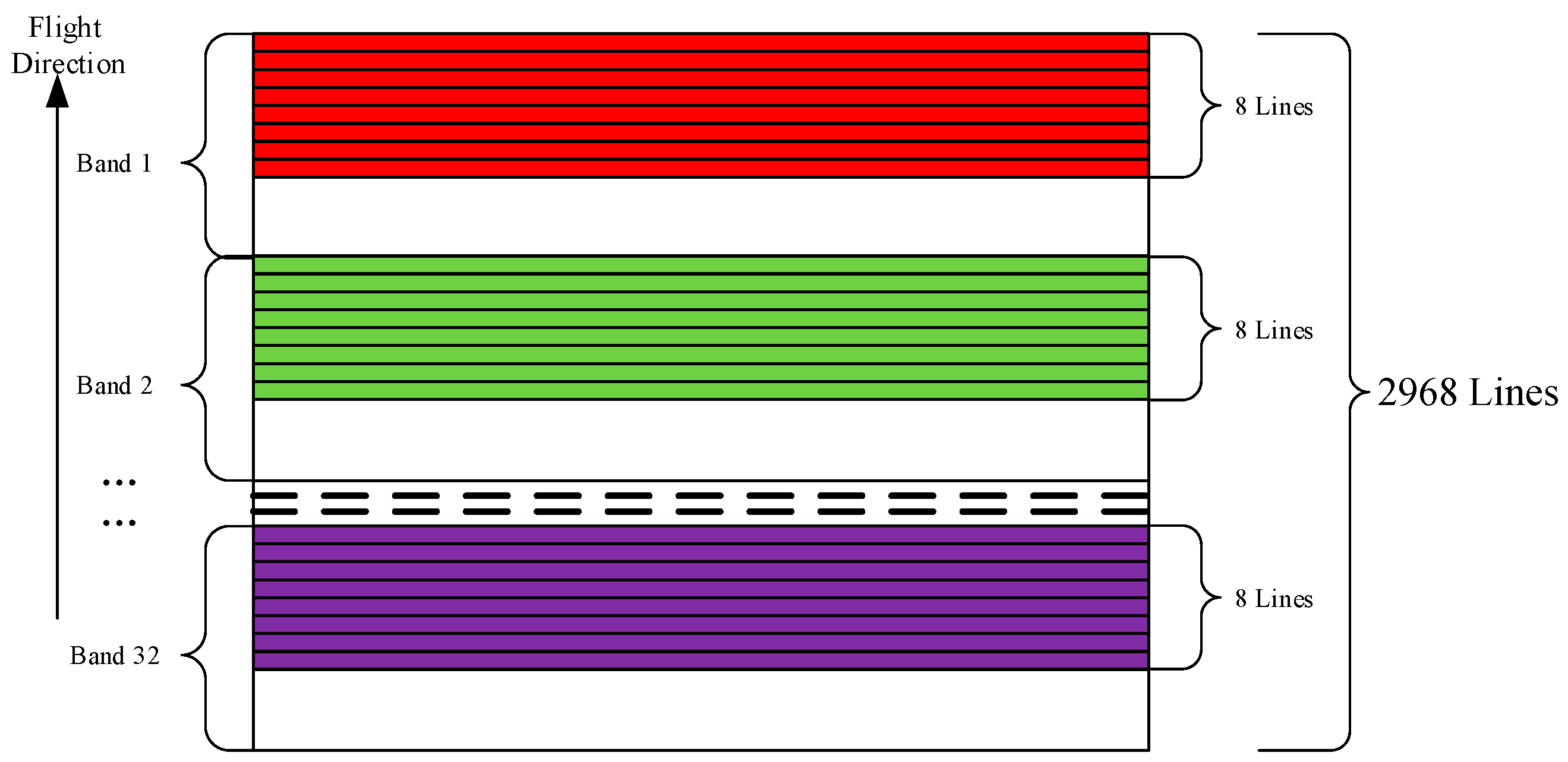
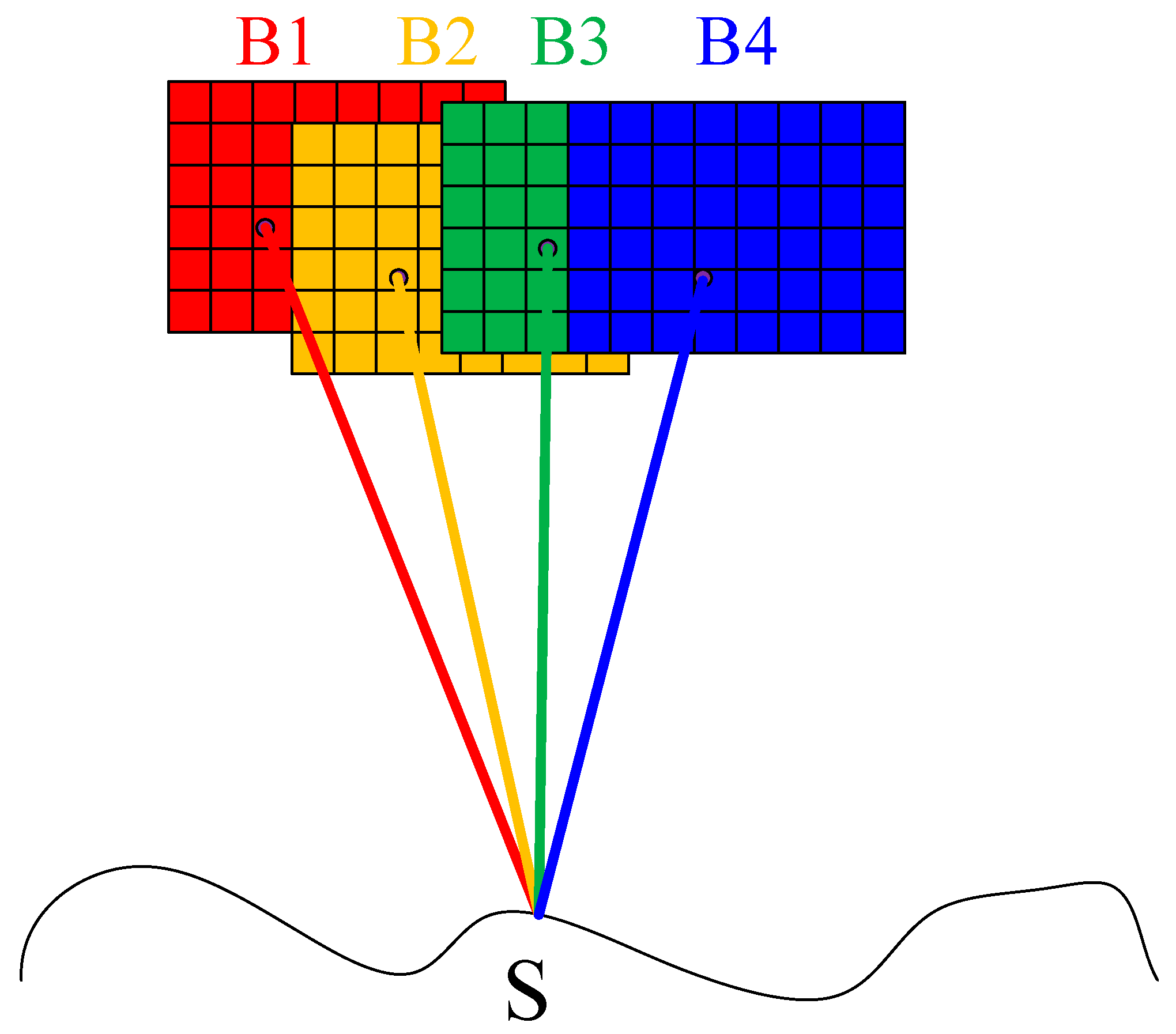

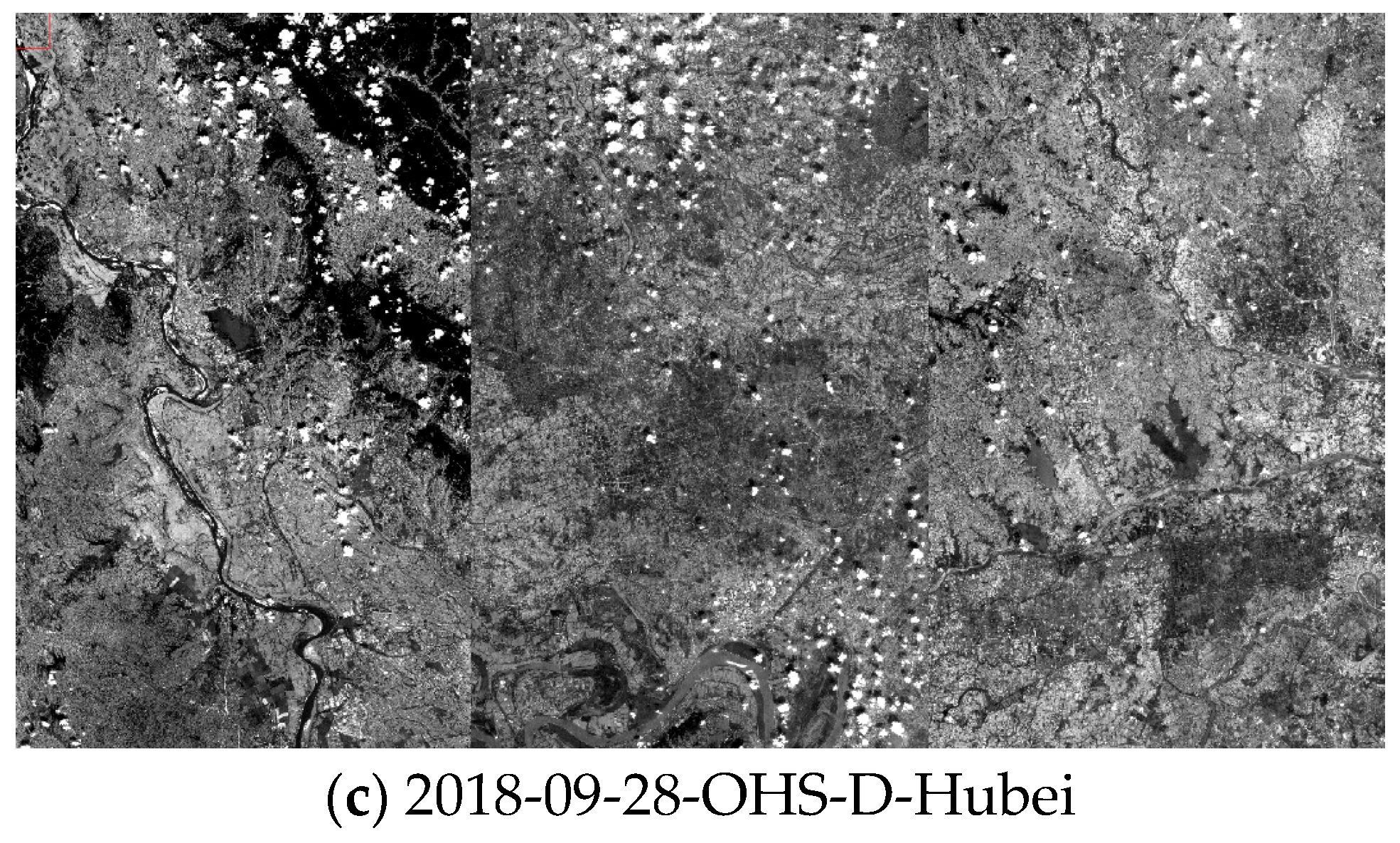
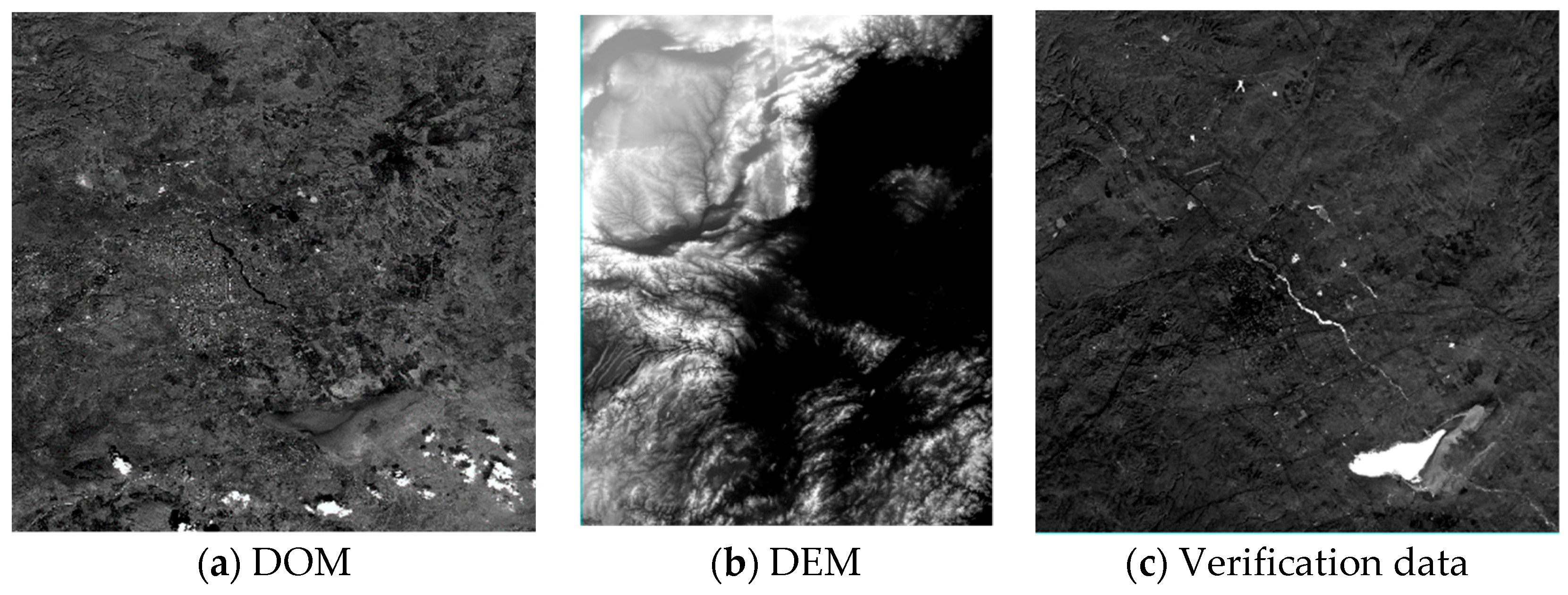


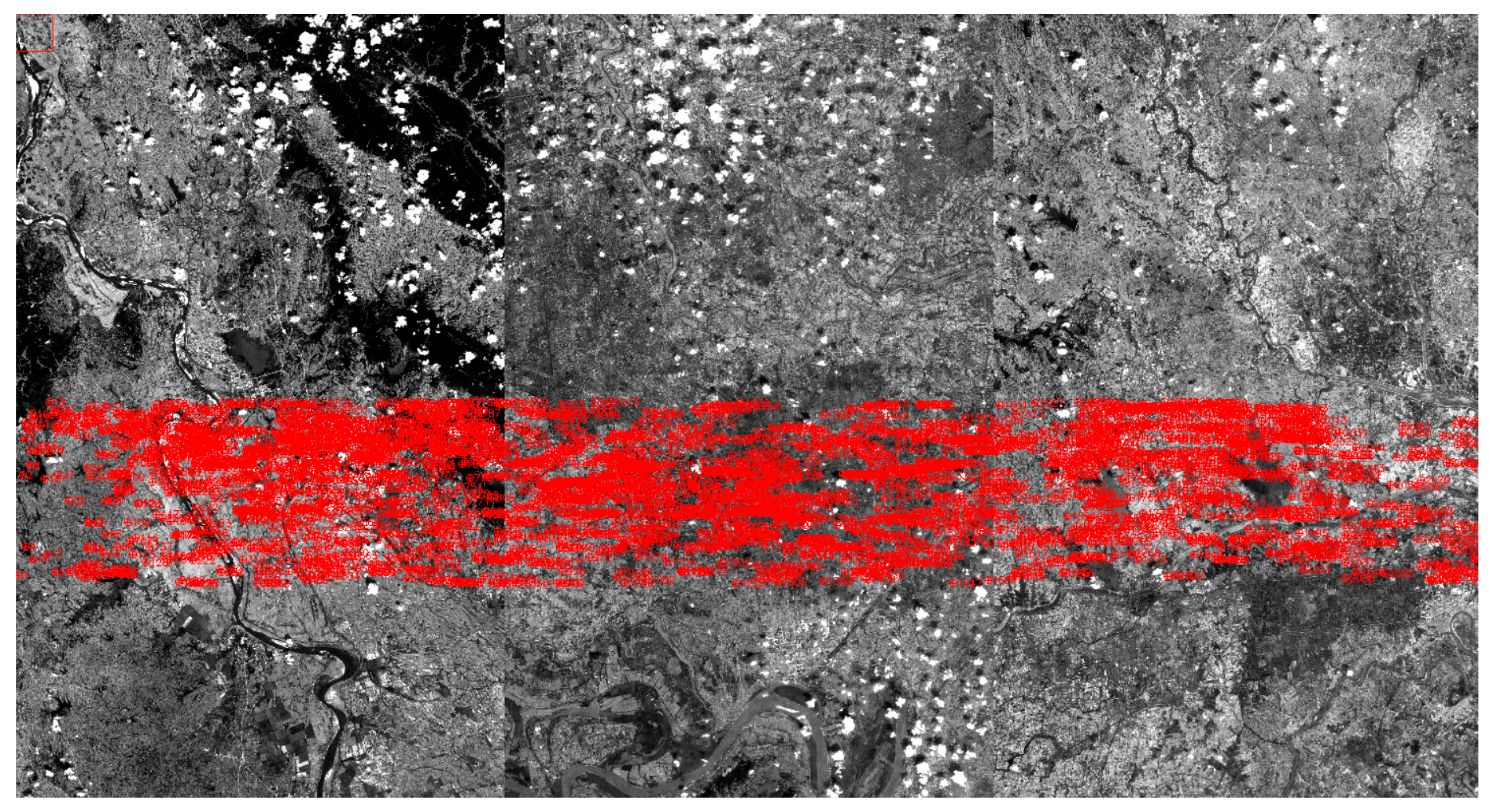
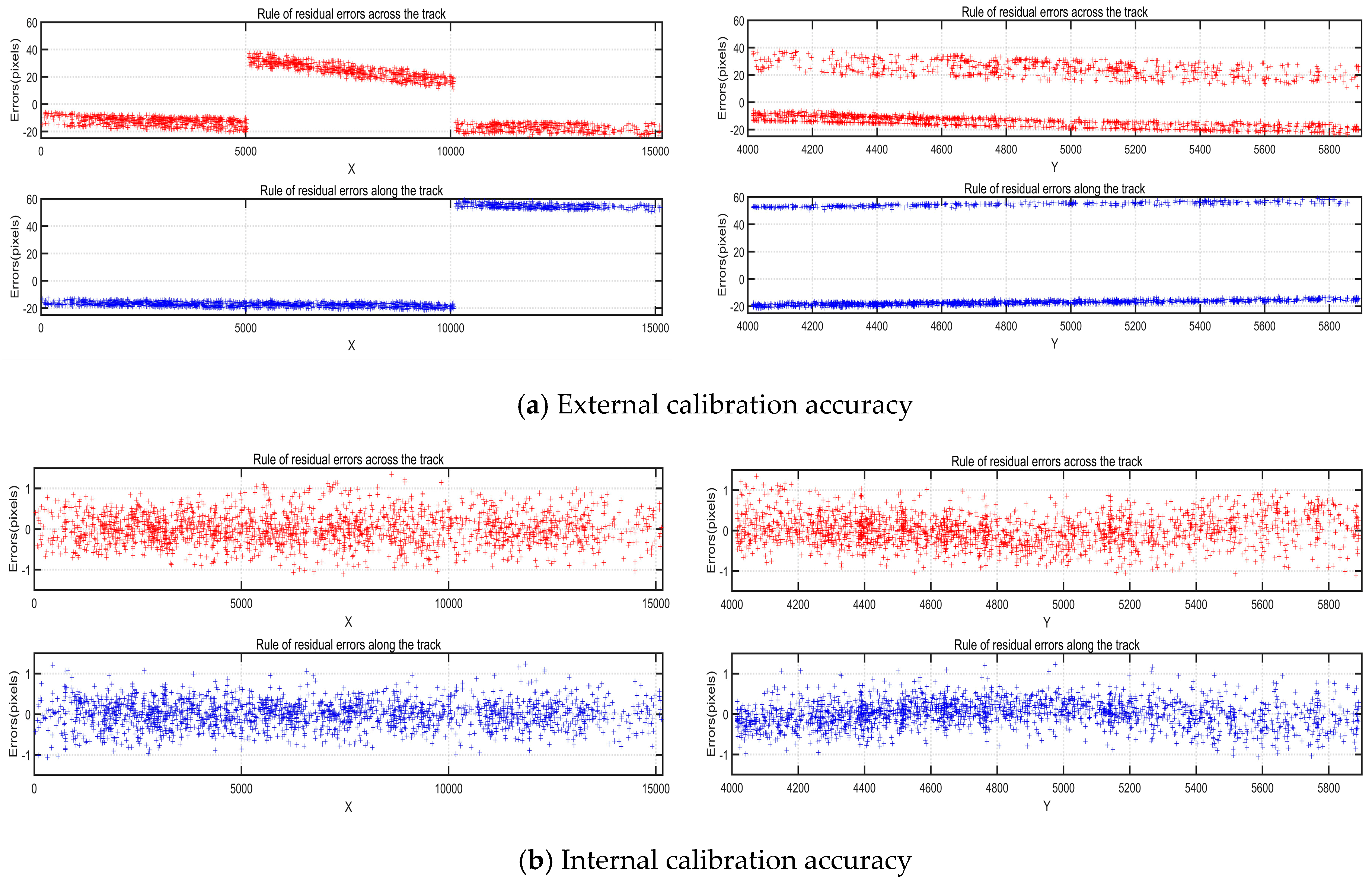

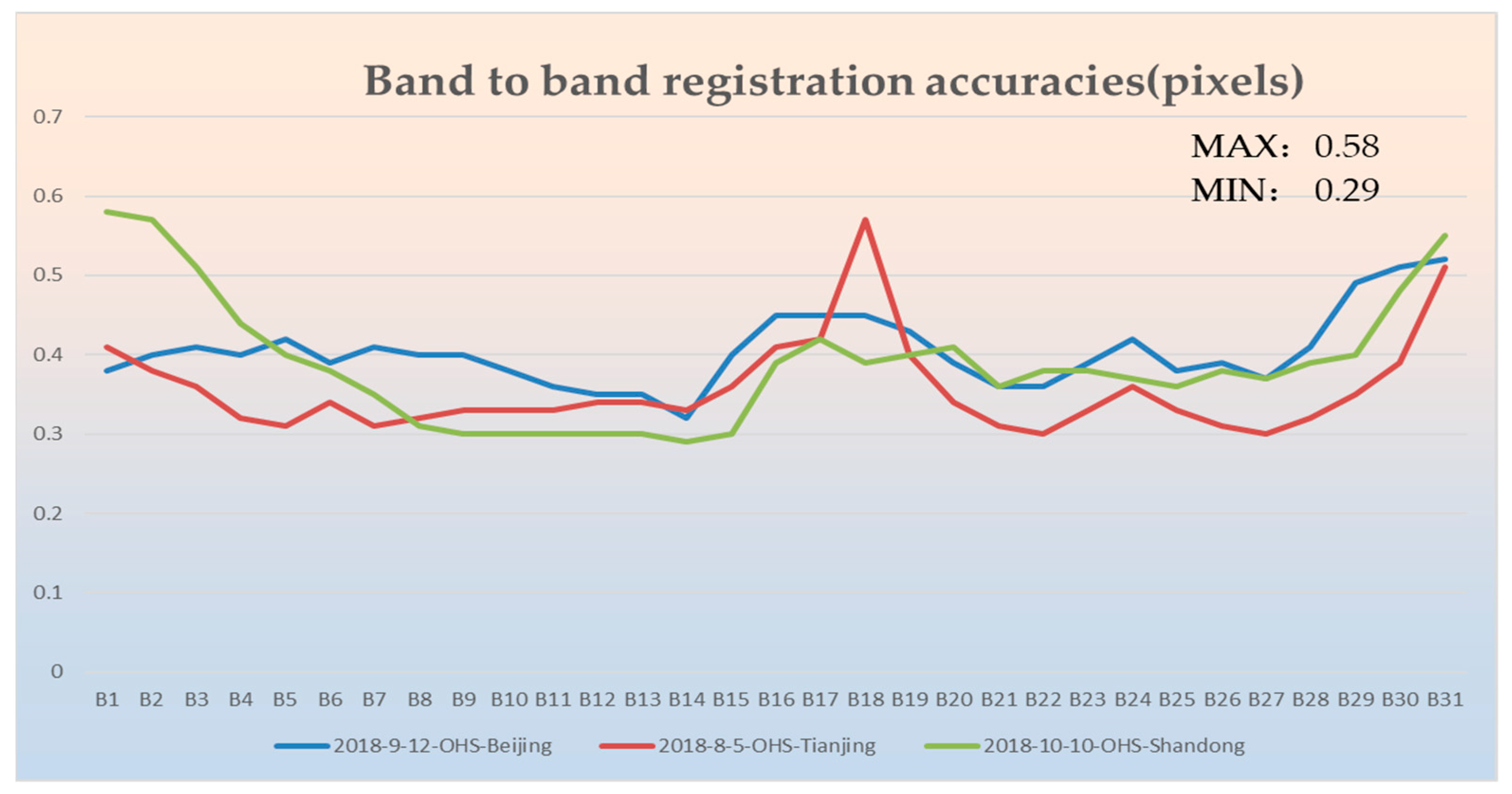
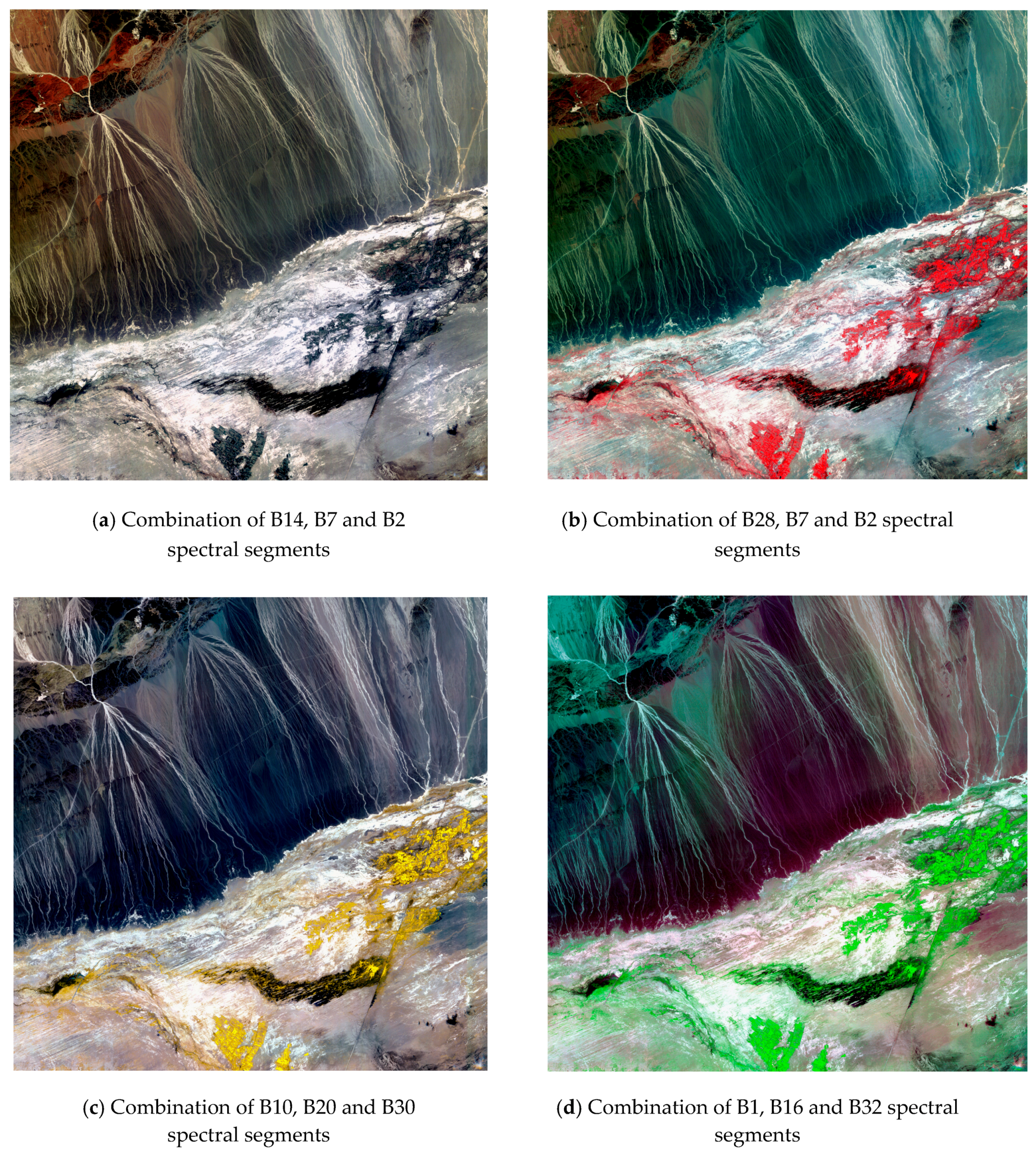

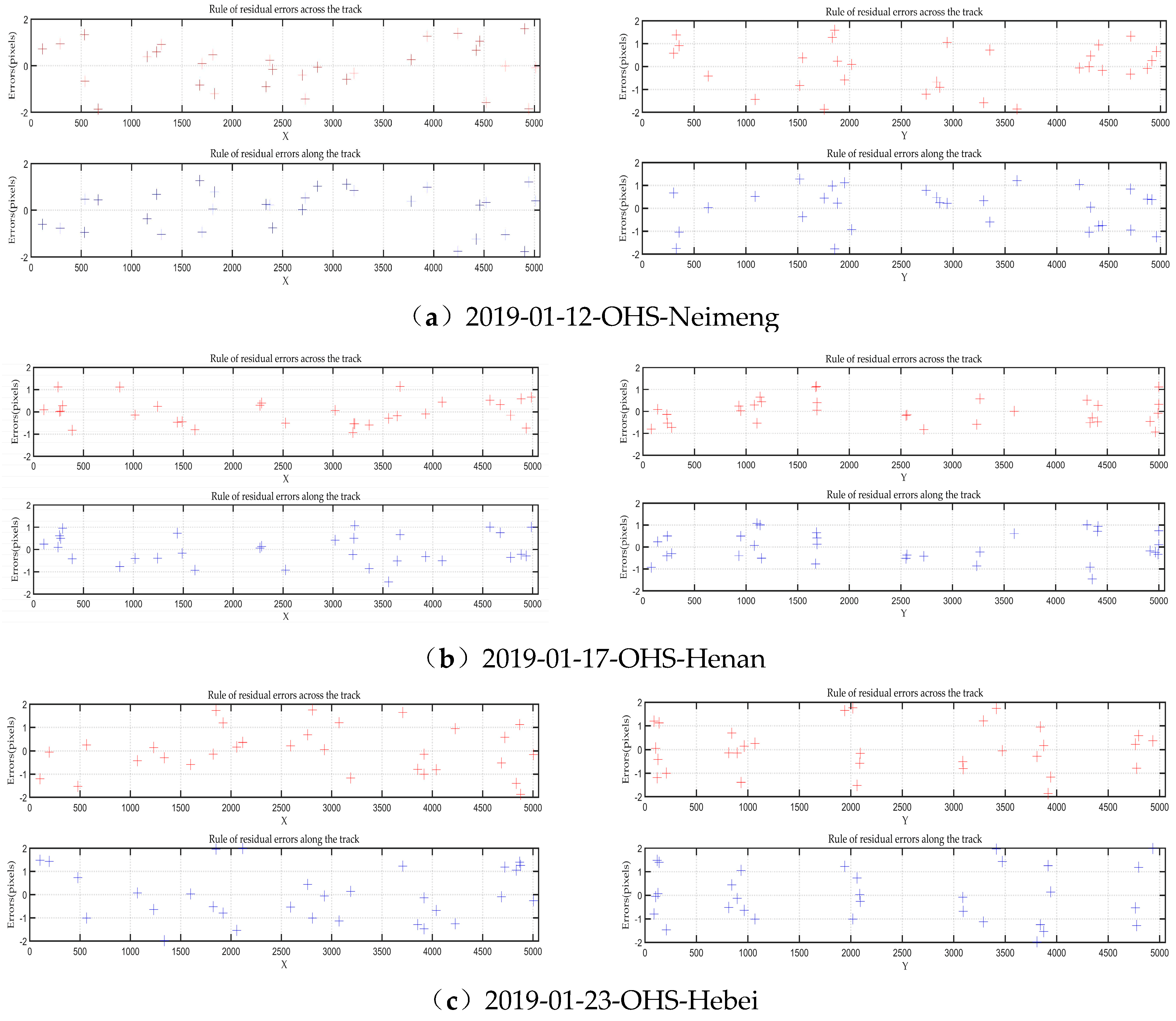
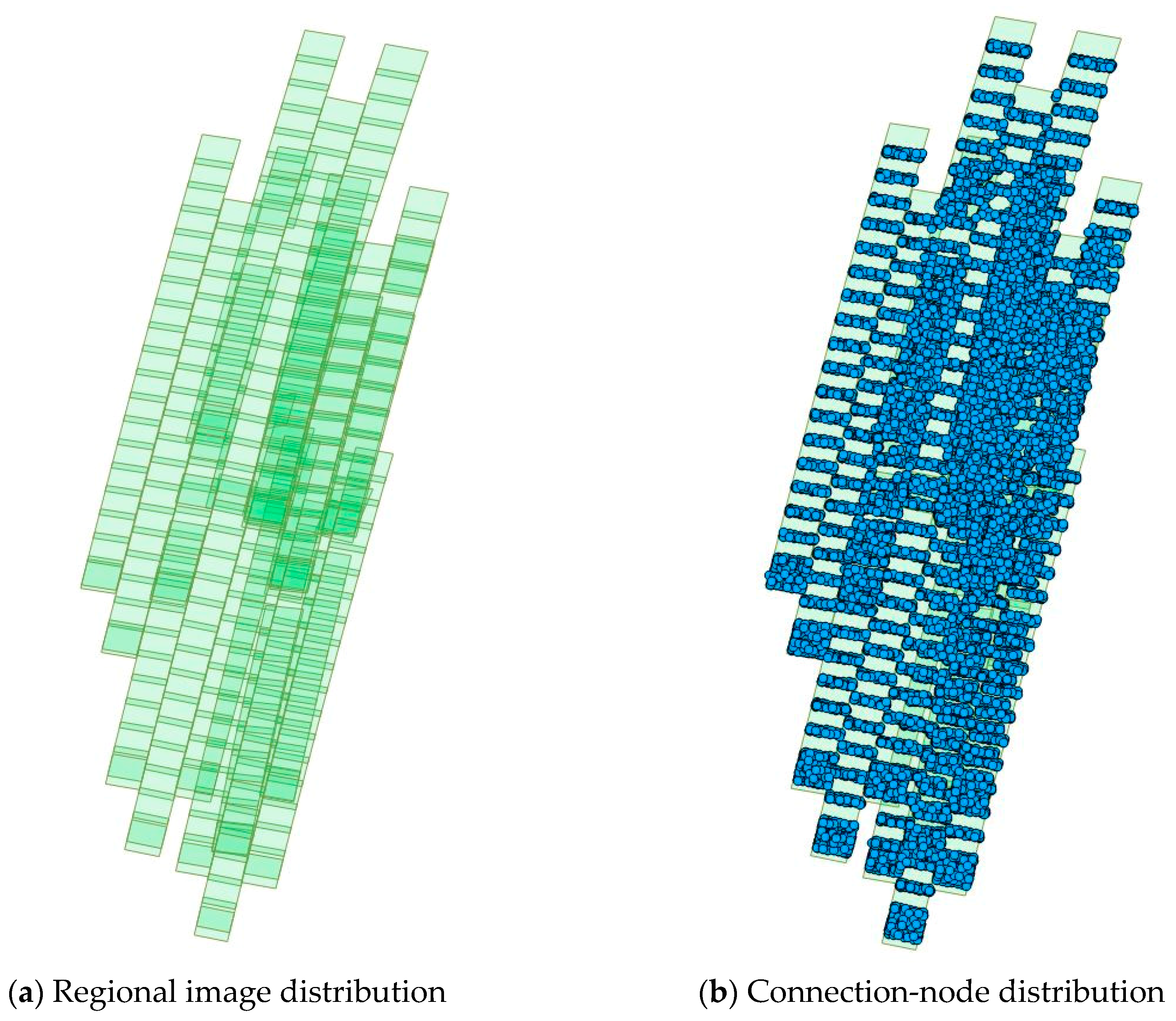
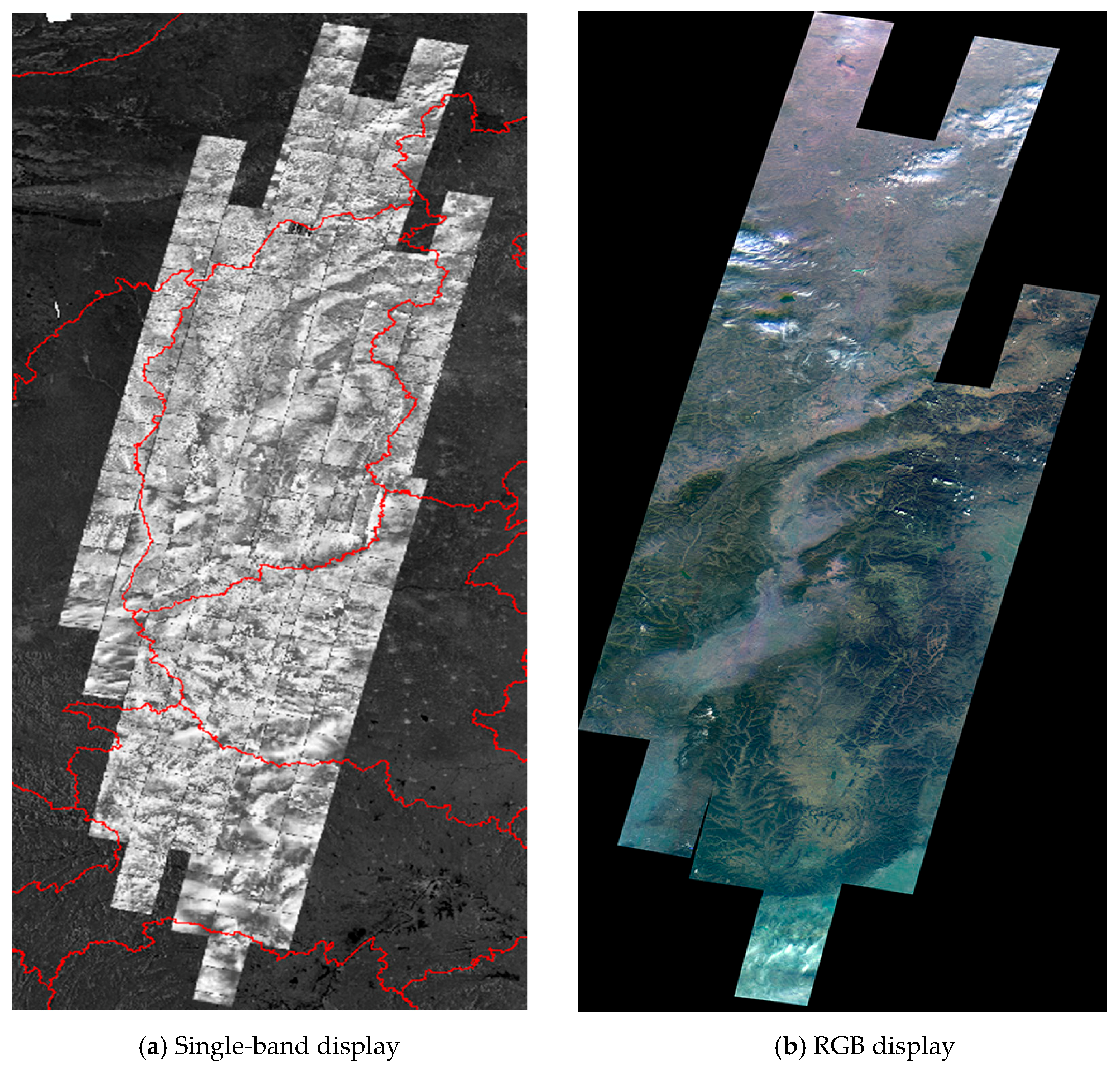


| Satellite Platform | Total satellite mass | 67 kg |
| Orbit height | 500 km | |
| Orbit inclination angle | 98° | |
| Regression cycle | 5 days | |
| Global positioning system (GPS) positioning precision | 15 m | |
| Attitude accuracy | 15″ (3) | |
| Attitude maneuver | ±45°/80 s | |
| Attitude stability | 0.002°/s (1) | |
| Satellite Payload | Detector size | 4.4 µm |
| Field of view (FOV) | 20.5° | |
| Spectral range | 400–1000 nm | |
| Quantitative level | ≥12 bits | |
| Band number | 32 | |
| Signal Noise Ratio (SNR) | ≥300 dB | |
| Ground sample distance | 10 m | |
| Ground swath | 150 km |
| ID | Imaging Angle (°) | Imaging Time | Band | ||
|---|---|---|---|---|---|
| Roll | Pitch | Yaw | |||
| 3.2. Geometric Calibration | |||||
| 2018-09-28-OHS-Hubei | −1.09° | 0.00° | 3.18° | 2018-09-28 | 1-32 |
| 3.3. Band-to-Band Registration Accuracy | |||||
| 2018-9-12-OHS-Beijing | −5.26° | 0.00° | 2.81° | 2018-09-12 | 1-32 |
| 2018-8-5-OHS-Tianjing | −11.85° | 0.00° | 2.72° | 2018-08-05 | 1-32 |
| 2018-10-10-OHS-Shandong | −1.26° | 0.00° | 2.95° | 2018-10-10 | 1-32 |
| 3.4. Interior Orientation Determination Accuracy Evaluation | |||||
| 2019-01-13-OHS-Neimeng | 11.84° | 0.00° | 2.72° | 2019-01-13 | 15 |
| 2019-01-17-OHS-Henan | 2.94° | 0.00° | 3.00° | 2019-01-17 | 15 |
| 2019-01-24-OHS-Hebei | −0.50° | 0.01° | 2.90° | 2019-01-24 | 15 |
| 3.5. Block Adjustment | |||||
| 2018-08-12-OHS-Shanxi | 8.64° | 0.00° | 2.93° | 2018-08-12 | 15 |
| 2018-11-21-OHS-Shanxi | −8.69° | 0.00° | 2.78° | 2018-11-21 | 15 |
| 2018-09-07-OHS-Shanxi | 3.52° | 0.00° | 2.79° | 2018-09-07 | 15 |
| 2018-11-19-OHS-Shanxi | 9.82° | 0.00° | 2.65° | 2018-11-19 | 15 |
| Sample (Pixels) | Line (Pixels) | Plane RMS (Pixels) | |||||
|---|---|---|---|---|---|---|---|
| MAX | MIN | RMS | MAX | MIN | RMS | ||
| a | 37.34 | 6.12 | 19.44 | 59.10 | 12.67 | 30.79 | 36.42 |
| b | 1.34 | 0.00 | 0.38 | 1.22 | 0.00 | 0.32 | 0.50 |
| ID | Sample (Pixels) | Line (Pixels) | Plane Accuracy RMS (Pixels) | ||||||
|---|---|---|---|---|---|---|---|---|---|
| MAX | MIN | MEANS | STD | MAX | MIN | MEANS | STD | ||
| 2019-01-12-OHS-Neimeng | 1.86 | 0.01 | 0.00 | 0.96 | 1.77 | 0.03 | 0.00 | 0.87 | 1.30 |
| 2019-01-17-OHS-Henan | 1.14 | 0.01 | 0.00 | 0.57 | 1.46 | 0.07 | 0.00 | 0.66 | 0.87 |
| 2019-01-23-OHS-Hebei | 1.87 | 0.05 | 0.00 | 0.96 | 1.99 | 0.03 | 0.00 | 1.10 | 1.46 |
| ID | Connection Points | RMS (pixels) | ||
|---|---|---|---|---|
| x | y | Plane | ||
| Test area | 13,086 | 0.642 | 0.954 | 1.150 |
© 2019 by the authors. Licensee MDPI, Basel, Switzerland. This article is an open access article distributed under the terms and conditions of the Creative Commons Attribution (CC BY) license (http://creativecommons.org/licenses/by/4.0/).
Share and Cite
Jiang, Y.; Wang, J.; Zhang, L.; Zhang, G.; Li, X.; Wu, J. Geometric Processing and Accuracy Verification of Zhuhai-1 Hyperspectral Satellites. Remote Sens. 2019, 11, 996. https://doi.org/10.3390/rs11090996
Jiang Y, Wang J, Zhang L, Zhang G, Li X, Wu J. Geometric Processing and Accuracy Verification of Zhuhai-1 Hyperspectral Satellites. Remote Sensing. 2019; 11(9):996. https://doi.org/10.3390/rs11090996
Chicago/Turabian StyleJiang, Yonghua, Jingyin Wang, Li Zhang, Guo Zhang, Xin Li, and Jiaqi Wu. 2019. "Geometric Processing and Accuracy Verification of Zhuhai-1 Hyperspectral Satellites" Remote Sensing 11, no. 9: 996. https://doi.org/10.3390/rs11090996






